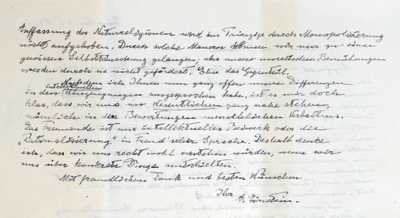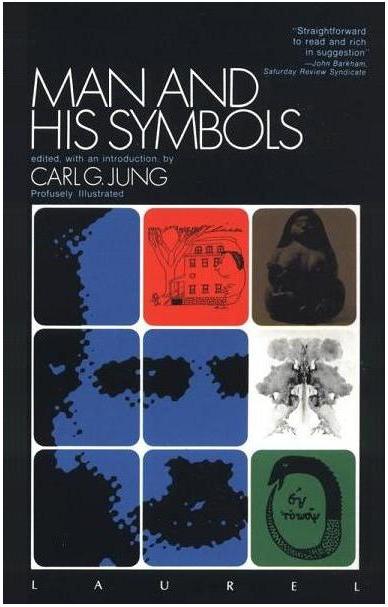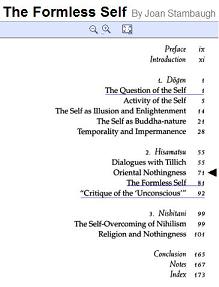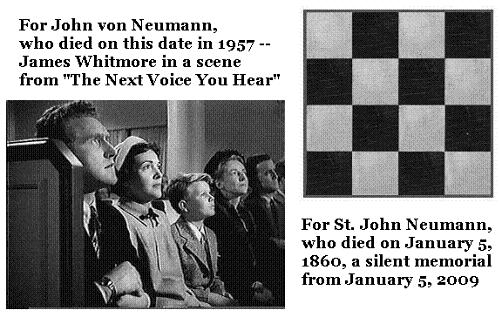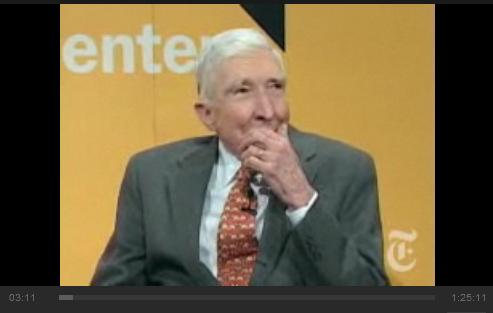From the journal of Steven H. Cullinane...
2009 February 01-15
Sunday, February 15, 2009 11:00 AM
Today's Sermon:
From April
28, 2008:
Religious Art
The black monolith of
Kubrick's 2001 is, in
its way, an example
of religious art.
 One artistic shortcoming
(or strength-- it is, after
all, monolithic) of
that artifact is its
resistance to being
analyzed as a whole
consisting of parts, as
in a Joycean epiphany.
The following
figure does
allow such
an epiphany.
One artistic shortcoming
(or strength-- it is, after
all, monolithic) of
that artifact is its
resistance to being
analyzed as a whole
consisting of parts, as
in a Joycean epiphany.
The following
figure does
allow such
an epiphany.
 One approach to
the epiphany:
"Transformations play
a major role in
modern mathematics."
- A biography of
Felix Christian Klein
One approach to
the epiphany:
"Transformations play
a major role in
modern mathematics."
- A biography of
Felix Christian Klein
See 4/28/08 for examples
of such transformations.
|
Related material:
From Wallace
Stevens: A World of Transforming Shapes, by Alan D. Perlis,
Bucknell University Press, 1976, pp. 117-118:
"... his point of origin is external nature, the fount to which we come
seeking inspiration for our fictions. We come, many of Stevens's poems
suggest, as initiates, ritualistically celebrating the place through
which we will travel to achieve fictive shape. Stevens's 'real' is a
bountiful place, continually giving forth life, continually changing.
It is fertile enough to meet any imagination, as florid and as
multifaceted as the tropical flora about which the poet often writes.
It therefore naturally lends itself to rituals of spring rebirth,
summer fruition, and fall harvest. But in Stevens's fictive world,
these rituals are symbols: they acknowledge the real and thereby enable
the initiate to pass beyond it into the realms of his fictions.
Two counter rituals help to explain the function of celebration as
Stevens envisions it. The first occurs in 'The
Pediment of Appearance,' a slight narrative poem in Transport
to Summer. A group of young men enter some woods 'Hunting for the
great ornament, The pediment of appearance.' Though moving through the
natural world, the young men seek the artificial, or pure form,
believing that in discovering this pediment, this distillation of the
real, they will also discover the 'savage transparence,' the rude
source of human life. In Stevens's world, such a search is futile,
since it is only through observing nature that one reaches beyond it to
pure form. As if to demonstrate the degree to which the young men's
search is misaligned, Stevens says of them that 'they go crying/The
world is myself, life is myself,' believing that what surrounds them is
immaterial. Such a proclamation is a cardinal violation of Stevens's
principles of the imagination. For in 'Notes Toward a Supreme Fiction'
he tells us that
... the first idea was not to shape the clouds
In imitation. The clouds preceded us.
There was a muddy centre before we breathed.
There was a myth before the myth began,
Venerable and articulate and complete.
From this the poem springs: that we live in a place
That is not our own and, much more, not ourselves
And hard it is in spite of blazoned days.
We are the mimics.
(Collected Poems, 383-84)
Believing that they are the life and not the mimics thereof, the world
and not its fiction-forming imitators, these young men cannot find the
savage transparence for which they are looking. In its place they find
the pediment, a scowling rock that, far from being life's source, is
symbol of the human delusion that there exists a 'form alone,' apart
from 'chains of circumstance.'
A far more productive ritual occurs in 'Sunday Morning.'...."
|
For transformations of a more
specifically religious nature,
see the remarks on
Richard Strauss,
"Death and Transfiguration,"
(Tod und Verklärung, Opus 24)
in
Mathematics
and Metaphor
on July 31, 2008, and the entries
of
August
3, 2008, related to the
death of Alexander Solzhenitsyn.
Saturday, February 14, 2009 9:29 PM
Annals of Religion:
The Devil
in the Details
The Bloomsbury Auctions caption for these images is as follows:
303. Einstein (Albert, theoretical physicist,
1879-1955) Autograph Letter signed to
Eric B. Gutkind, in German, 1½pp. & envelope,
4to, Princeton, 3rd January 1954, thanking him for a copy of his
book and expressing his view of God and Judaism, [The word God is for
me nothing more than the expression and product of human weaknesses,
the Bible a collection of honorable, but still primitive legends which
are nevertheless pretty childish... . For me the Jewish religion like
all other religions is an incarnation of the most childish
superstitions. And the Jewish people to whom I gladly belong and with
whose mentality I have a deep affinity have no different quality for me
than all other people...], folds, slightly browned ; and a
photograph of Gutkind, v.s., v.d.
est. £6000 – £8000
Einstein’s view of God and Judaism.
Eric B. Gutkind (1877-1965), philosopher; author of Choose
Life: The Biblical Call to Revolt, 1952.
Albert Einstein - see also lot 497
Sold for £170000
Sale 649, 15th May 2008
Here is a close reading of the part of the letter itself that
Bloomsbury gives in English, transcribed from the above images.
Line-by-line transcription of paragraph 2, starting at line 4 of that
paragraph:
... Das Wort Gott ist für mich nichts als Ausdruck
und Produkt menschlicher Schwächen, die Bibel eine Sammlung
ehrwürdiger, aber doch reichlich primitiver Legenden. Keine noch
so feinsinnige Auslegung kann (für mich) etwas daran ändern.
Diese verfeinerten Auslegungen sind naturgemäß höchst mannigfaltig
und haben so gut wie nichts mit dem Urtext zu schaffen. Für
mich ist die unverfälschte jüdische Religion, wie alle anderen
Religionen, eine Inkarnation des primitiven Aberglaubens. Und das
jüdische Volk, zu dem ich gern gehöre und mit dessen Mentalität ich
tief verwachsen bin, hat für mich doch keine andersartige
Qualität als alle anderen Völker. So weit meine Erfahrung reicht,
ist es auch um nichts besser als andere menschliche Gruppierungen,
wenn es auch durch Mangel an Macht gegen die schlimmsten
Auswüchse gesichert ist. Ansonsten kann ich nichts "Auserwähltes"
an ihm wahrnehmen.
The
Guardian of May 13, 2008 stated that the following was
"translated from German by Joan Stambaugh"--
... The word God is for me nothing more than the expression
and product of human weaknesses, the Bible a collection
of honourable, but still primitive legends which are nevertheless pretty childish. No
interpretation no matter how subtle can (for me) change this.
These subtilised interpretations are highly manifold
according to their nature and have almost nothing to do with the original text. For
me the Jewish religion like all other
religions is an incarnation of the most childish [German: primitiven] superstitions. And the
Jewish people to whom I gladly belong and with whose mentality I
have a deep affinity have no different
quality for me than all other people. As far as my experience goes,
they are also no better than other human groups,
although they are protected from the worst
cancers by a lack of power. Otherwise I cannot see anything 'chosen'
about them.
Phrases by Stambaugh that do not appear in the German text are
highlighted.
Stambaugh, a philosophy professor, is the author of a work on Buddhism,
The Formless Self. For some related material on young men who
"go crying 'The world is myself, life is myself'" in May, see Wallace
Stevens's "The
Pediment of Appearance."
Saturday, February 14, 2009 12:00 PM
Annals of Romance:
Friday, February 13, 2009 7:36 PM
The Rest of the Story:
Fire and Ice
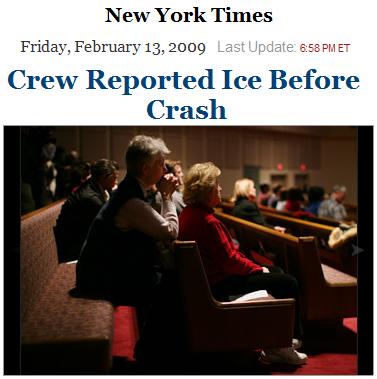
Prologue from
Answers.com:
bombardier
The member of a
combat aircraft crew who
operates the bombsight
and drops the bombs.
|
February 13, 2009 -- Toronto
Press
Release
Bombardier confirms a Dash 8 Q400 aircraft was
involved in an accident near Buffalo, New York on February 12. We
extend our sympathies to the families of those who perished in this
accident. Bombardier has dispatched a product safety and technical team
to the site to assist the National Transportation Safety Board with
their investigation.
Until such time as the investigators release any information
or findings, Bombardier cannot comment further or speculate on the
cause of this accident.
Bombardier Q400 product information is available on
www.q400.com.
|
Friday, February 13, 2009 9:26 AM
Annals of Religion:
DENNIS OVERBYE
"From the grave, Albert Einstein poured gasoline on the culture wars
between science and religion this week.
A letter the physicist
wrote in 1954 to the philosopher Eric Gutkind, in which he described
the Bible as 'pretty childish'...."
This morning's
New York Times:
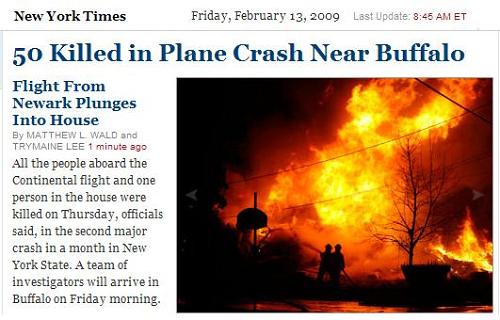
The plane crashed at about 10:20 PM.
Meanwhile...
Yesterday evening in Springfield (as
scheduled):
6:20 PM THE PRESIDENT arrives in Springfield, IL
7:00 PM THE PRESIDENT delivers remarks at the 102nd Abraham Lincoln
Association Annual Banquet
8:30 PM THE PRESIDENT departs from Springfield, IL
Religious summary by
Buffalo
Springfield:
"Stop, children,
what's that sound?
Everybody look
what's going down." |
Friday, February 13, 2009 12:00 AM
Childish Things, continued:
Happy
birthday to
King Friday XIII
and friend:
 Yesterday, by the way,
Yesterday, by the way,
was Georgia
Day
in Savannah.

"I Put a Spell on You"
-- Nina Simone,
title of autobiograpy
"The voodoo priestess looked across the table at her wealthy client, a
man on trial for murder: 'Now, you know how dead time works. Dead time
lasts for one hour-- from half an hour before midnight to half an hour
after midnight. The half-hour before midnight is for doin' good. The
half-hour after midnight is for doin' evil....'"
-- Glenna Whitley, "Voodoo Justice," The New York Times, March
20, 1994
Thursday, February 12, 2009 11:11 AM
Annals of Philosophy:
Headliners
Today, many observe
the 200th anniversary
of the birth of two
noted philosophers
of death:
Charles Darwin and
Abraham Lincoln.
A fitting headline:
FAUST
VIVIFIES DEATH
(Harvard Crimson,
February 7, 2008)
Happy birthday,
Cotton Mather.
Robert Stone,
A Flag for Sunrise:

"Our
secret culture is as frivolous as a willow on a tombstone. It's a
wonderful thing-- or it was. It was strong and dreadful, it was
majestic and ruthless. It was a stranger to pity. And it's not for
sale, ladies and gentlemen."
Wednesday, February 11, 2009 9:48 AM
Church of the Forbidden Planet:
Tuesday, February 10, 2009 11:07 PM
The Drama of...
"Brams...
uses elementary ideas from game theory to create situations between a
Person (P) and God (Supreme Being, SB) and discusses how each reacts to
the other in these model scenarios...."

(The number-pairs here reflect
relative values of the situations
the author assigns to SB and to P.)
Related Material
on theology and drama --
the two Log24 entries on
Stephen
King's birthday, 2008.
Tuesday, February 10, 2009 7:11 PM
Annals of Finance:
Coming Soon!
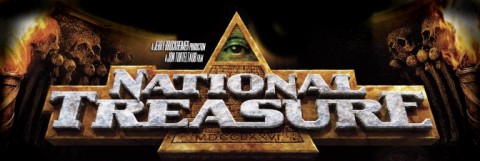 Trailer:
Trailer:
 "Now, here's my plan..."
"Now, here's my plan..."
"'What plan?' asked Bert Ely, an Alexandria, Va., banking consultant.
'The devil is in the details, and the details are hiding in the bushes
or deep underground.'
The Dow, which was down only about 70 points before Geithner's speech,
fell sharply as soon as he began talking."
--
Walter
Hamilton in The Los Angeles Times today
Monday, February 9, 2009 12:12 PM
Annals of Philosophy:
The Vision Thing
The British Academy Awards last
night showed two Paul Newman clips:
"Sometimes nothin' can be a real cool hand."
"Boy, I got vision
and the rest of the world wears bifocals."
Related material: This journal, September 2008.
As for bifocals...

Pennsylvania Lottery

|
|
|
|
Sunday, February 8, 2009 11:00 AM
Today's Sermon:
Saturday, February 7, 2009 2:02 PM
Culture Wars continued:
DENNIS OVERBYE
"From the grave, Albert Einstein poured gasoline on the culture
wars between science and religion this week.
A letter the physicist wrote in 1954 to the philosopher Eric
Gutkind, in which he described the Bible as 'pretty childish' and
scoffed at the notion that the Jews could be a 'chosen people,' sold
for $404,000 at an auction in London. That was 25 times the presale
estimate."
Einstein did not, at least in the place alleged, call the Bible
"childish." Proof:

The
image
of the letter is
from
the Sept./Oct. 2008
Search Magazine.
By the way, today is
the
birthday of G. H. Hardy.
Here is an excerpt from
his
thoughts
on childish things:
"What 'purely aesthetic' qualities can we distinguish
in such theorems as Euclid's or Pythagoras's?.... In both theorems (and
in the theorems, of course, I include the proofs) there is a very high
degree of unexpectedness, combined with inevitability
and economy. The arguments take so odd and surprising a form;
the weapons used seem so childishly
simple when compared with the far-reaching results; but there is no
escape from the conclusions."

"Space: what you
damn well have to see."
-- James Joyce, Ulysses
Friday, February 6, 2009 4:00 AM
ART WARS continued:
Eternal City
Today's New York Times:
"Olga Raggio was born in Rome on Feb. 5, 1926, to a Russian mother and
an Italian father. She earned a diploma from the Vatican library school
in 1947 and a Ph.D. from the University of Rome in 1949."
"... Raggio, an internationally known scholar and curator who in almost
60 years with the Metropolitan Museum of Art organized some of its
best-known exhibitions, scoured the world for treasure and coaxed
rarely seen artworks from places as far flung as the Vatican and as
close at hand as a New Jersey abbey, died on Jan. 24 in the Bronx. She
was 82 and lived in Manhattan."
Quoted here on
the date of Raggio's death:
"Death is not earnest in the same way the eternal is.
To the earnestness of death belongs precisely that capacity for
awakening, that resonance of a profound mockery which, detached from
the thought of the eternal, is an empty and often brash jest, but
together with the thought of the eternal is just what it should be,
utterly different from the insipid solemness which least of all
captures and holds a thought with tension like that of death."
-- Soren Kierkegaard, Works of Love, Harper
Torchbooks, 1964, p. 324
Related material:
February
2, 3, and 4 as well as
February
5 (Raggio's birthday).
Thursday, February 5, 2009 1:00 PM
ART WARS in review--
Through the
Looking Glass:
A Sort of Eternity
From the new president's inaugural address:
"... in the words of Scripture, the time has come to set aside childish
things."
The words of Scripture:
| 9 |
For we know in part, and we
prophesy in part.
|
| 10 |
But when that which is perfect is
come, then that which is in part shall be done away.
|
| 11 |
When I was a child, I spake as a
child, I understood as a child, I thought as a child: but when I became
a man, I put away childish things.
|
| 12 |
For now we see through a glass,
darkly, but then face to face: now I know in part; but then shall I
know even as also I am known.
-- First Corinthians
13
|
"through a glass"--
[di’
esoptrou].
By means of
a mirror [esoptron].
Childish things:

 © 2005 The Institute for Figuring
© 2005 The Institute for Figuring
Photo by Norman Brosterman
fom the Inventing
Kindergarten
exhibit at The
Institute for Figuring
(co-founded by Margaret Wertheim)
Not-so-childish:
Three planes through
the center of a cube
that split it into
eight subcubes:
 Through a glass, darkly:
Through a glass, darkly:
A group of 8 transformations is
generated by
affine
reflections
in the above three planes.
Shown below is a pattern on
the faces of the 2x2x2 cube
that is symmetric under one of
these 8 transformations--
a 180-degree rotation:

(Click on image
for further details.)
But then face to face:
A larger group of 1344,
rather than 8, transformations
of the 2x2x2 cube
is generated by a different
sort of affine reflections-- not
in the infinite
Euclidean 3-space
over the field of real numbers,
but rather in the finite
Galois
3-space over the 2-element field.
 Galois age fifteen,
Galois age fifteen,
drawn by a classmate.
These transformations
in the
Galois space with
finitely many points
produce a set of
168 patterns
like the one above.
For each such pattern,
at least one nontrivial
transformation in the group of 8
described above is a symmetry
in the
Euclidean space with
infinitely many points.
For some generalizations,
see
Galois
Geometry.
Related material:
The central aim of Western religion--
"Each of us has something to offer the Creator...
the bridging of
masculine and feminine,
life and death.
It's redemption.... nothing else matters."
-- Martha Cooley in The Archivist (1998)
The central aim of Western philosophy--
Dualities of Pythagoras
as reconstructed by Aristotle:
Limited Unlimited
Odd Even
Male Female
Light Dark
Straight Curved
... and so on ....
"Of these dualities, the first is the most important; all the
others may be seen as different aspects of this fundamental dichotomy.
To establish a rational and consistent relationship between the limited
[man, etc.] and the unlimited [the cosmos, etc.] is... the central aim
of all Western philosophy."
-- Jamie James in The Music of the Spheres (1993)
"In the garden of Adding
live Even and Odd...
And the song of love's recision
is the music of the spheres."
-- The Midrash Jazz Quartet in City of God, by E. L.
Doctorow (2000)
A quotation today at art critic Carol Kino's website, slightly expanded:
"Art inherited from the old religion
the power of consecrating things
and endowing them with
a sort of eternity;
museums are our temples,
and the objects displayed in them
are beyond history."
-- Octavio Paz,"Seeing and Using: Art and Craftsmanship," in
Convergences: Essays on Art and Literature (New York: Harcourt Brace
Jovanovich 1987), 52
From Brian O'Doherty's 1976 Artforum essays-- not
on museums, but rather on gallery space:
"Inside the White Cube"
"We have now reached
a point where we see
not the art but the space first....
An image comes to mind
of a white, ideal space
that, more than any single picture,
may be the archetypal image
of 20th-century art."

"Space: what you
damn well have to see."
-- James Joyce, Ulysses
|
Wednesday, February 4, 2009 1:23 PM
ART WARS continued:
Wednesday, February 4, 2009 5:18 AM
Knock, Knock, Knockin'...
Tuesday, February 3, 2009 7:59 AM
Annals of Philosophy:
Everything and Nothing
"I know what 'nothing' means...."
-- Joan Didion, Play It As It Lays, Farrar, Straus and Giroux, 1990
paperback, page 214
"In 1935, near the end of a long affectionate letter to his son George
in America, James Joyce wrote: 'Here I conclude. My eyes are tired. For
over half a century they have gazed into nullity, where they have found
a lovely nothing.'"
-- Lionel Trilling, "James Joyce in His Letters," Commentary,
45, no. 2 (Feb. 1968), abstract
"The quotation is from The Letters of James Joyce, Volume III,
ed. Richard Ellman (New York, 1966), p. 359. The original Italian reads
'Adesso termino. Ho gli occhi stanchi. Da più di mezzo secolo
scrutano nel nulla dove hanno trovato un bellissimo niente.'"
-- Lionel Trilling: Criticism and Politics, by William M. Chace,
Stanford U. Press, 1980, page 198, Note 4 to Chapter 9
"Space: what you damn well have to see."
-- James Joyce, Ulysses
"What happens to the concepts of space and direction
if all the matter in the universe is removed save a small finite number
of particles?"
-- "On the Origins
of Twistor Theory," by Roger Penrose
"... we can look to the prairie, the darkening sky, the birthing
of a funnel-cloud to see in its vortex the fundamental structure of
everything..."
-- Against the Day, by Thomas Pynchon (See previous
entry.)
"A strange
thing then happened."
-- L.
Frank Baum
Monday, February 2, 2009 10:30 AM
ART WARS continued:
Against the Day
is
a novel by
Thomas Pynchon
published on Nov. 21, 2006, in
hardcover, and
in
paperback on
Oct. 30, 2007 (Devil's Night).
Perhaps
the
day the title
refers to is one of the above
dates... or perhaps it is--

The Candlebrow Conference
in Pynchon's Against the Day:
The conferees had gathered here from all around the world.... Their
spirits all one way or another invested in, invested by, the siegecraft
of Time and its mysteries.
"Fact is, our system of so-called linear time is based on a circular
or, if you like, periodic phenomenon-- the earth's own spin. Everything
spins, up to and including, probably, the whole universe. So we can
look to the prairie, the darkening sky, the birthing of a funnel-cloud
to see in its vortex the fundamental structure of everything--"

Quaternion by
S. H. Cullinane
"Um, Professor--"....
... Those in attendance, some at quite high speed, had begun to
disperse, the briefest of glances at the sky sufficing to explain why.
As if the professor had lectured it into being, there now swung from
the swollen and light-pulsing clouds to the west a classic prairie
"twister"....
... In the storm cellar, over semiliquid coffee and farmhouse crullers
left from the last twister, they got back to the topic of periodic
functions....
"Eternal Return, just to begin with. If we may construct such functions
in the abstract, then so must it be possible to construct more secular,
more physical expressions."
"Build a time machine."
"Not the way I would have put it, but if you like, fine."
Vectorists and Quaternionists in attendance reminded everybody of the
function they had recently worked up....
"We thus enter the whirlwind. It becomes the very essence of a
refashioned life, providing the axes to which everything will be
referred. Time no long 'passes,' with a linear velocity, but 'returns,'
with an angular one.... We are returned to ourselves eternally, or, if
you like, timelessly."
"Born again!" exclaimed a Christer in the gathering, as if suddenly
enlightened.
Above, the devastation had begun.
|
Sunday, February 1, 2009 9:00 AM
Mathematics and Narrative, continued:




